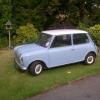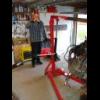The quick scientific explaination is that if you lok at the end of the drill bit, you will see a small flat straight edge before the cutting edge starts and then curves away to the edge of the bit. when you start the drill. it wants to slip sideways and then takes a bite, it then wants to slip again and take another bite. i still want to find out why as Tiger says, it always seems to end up triangular, especially if running a fast speed!
The reason for first having a small pilot hole ( as explained to me by my college lecturer many years ago "definitely old school" ) is that the pilot hole allows the flat centre of the drill bit to enter the hole therefore allowing the cutting edges to bite instantly rather than trying to slip sideways.
The reason for going up in size of bit in many slight stages is that when the drill takes its bite, the curvature of the cutting edge is trying to push the bit sideways in two directions (drills usually have two cutting edges) therefore in theory cancelling out the "push". this is pretty true on "new" bits, but those of us that hand sharpen their own bits, soon find out how important that each side of the drill is sharpened at exactly the same angle, length and clearance or this sideways push effect will be seen to be more prominent, as one side cuts keener therefore having more force available for the push!
If you dont understand, or agree with this theory, take maybe a 1 inch drill bit and experiment, with it.
And the final factor for wandering bits in sheet steel, is the fact that once the hole is started, there is nothing behind the sheet to stop the bit wandering. imagine a drill going into a solid block rather than a sheet, the bit is using the pilot hole to start, then the bit is forming a cone in front of it to keep itself on track and true. you may have seen this when starting a hole in a solid block. The drill bit will chatter around until it has formed a small conical shape to settle into, then it will smooth out and cut true.
To assist cutting sheet, a block held firmly behind it will allow this conical shape to form behind the sheet and keep the bit centred. This takes us back to a previous post recommending a block held behind the workpiece.
I am sure an Modern up to date engineer will be along soon, to put me right, but i am just passing on some theories given to me when training as a lad at college.
To state the reason why i use a cone cutter, once a small pilot hole is drilled, the cone cutter then uses just a narrow part of its cutting edge in the sides of the hole and its shape replicates the cone you would normally see in the backing block or solid part being drilled into, therefore centring itself once again.
BUT it is important to keep the cutter at 90 degrees to the workpiece, or one side will see a different cutting angle and will start to push the hole to one side.
Any arguments to these theories will be welcomed, as will any better theories and explanations.
May the force be with you.
YODA.

















